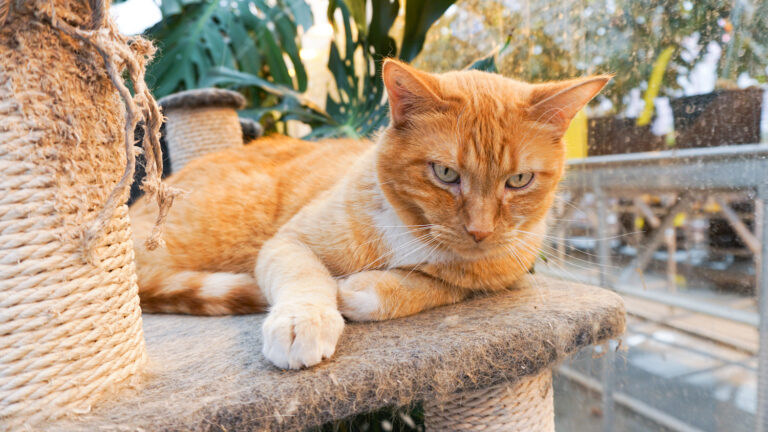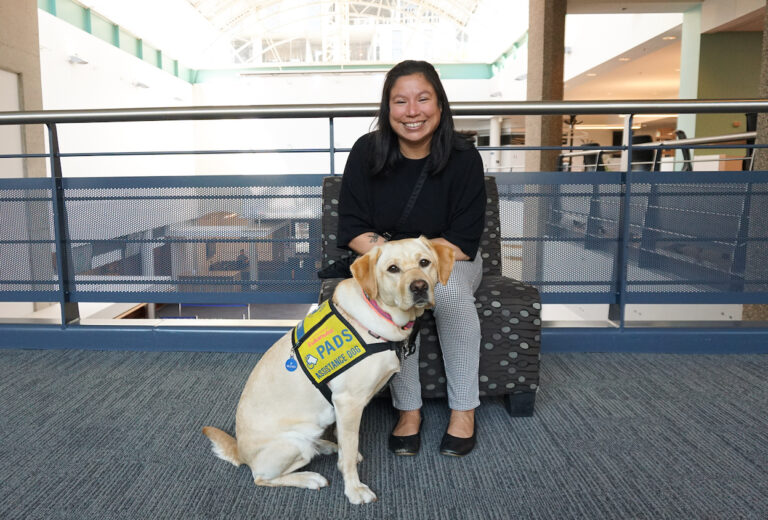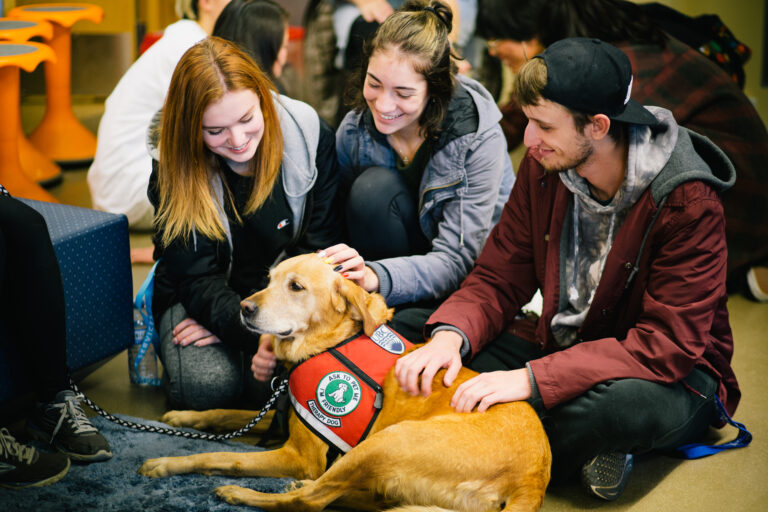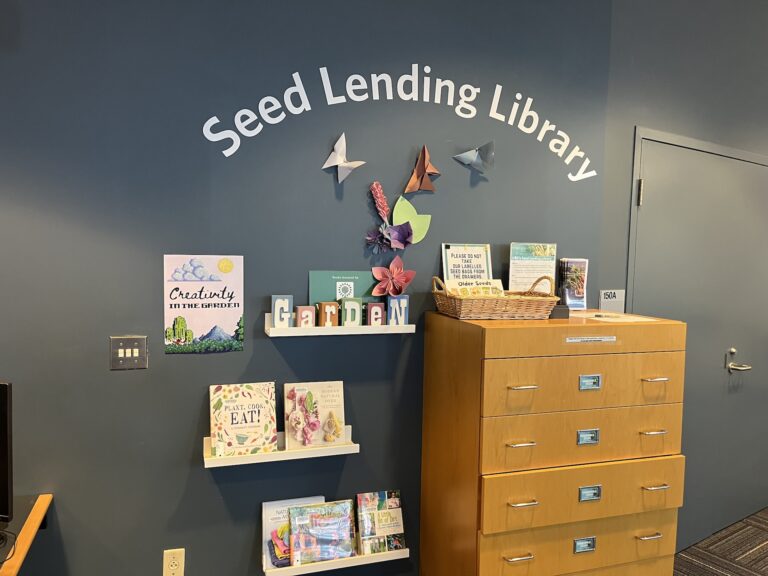UBC has thousands of employees, but only a handful of the four-legged variety.
Meet Charlie, Lola, Wilma and Daniel, the beloved “working” animals of UBC who make a paw-sitive impact on the university community.
The feline guardians of the greenhouse
If you’ve ever passed by the Horticulture Building, you might think it’s just a greenhouse filled with plants. It’s also home to feline “biological control agents” Charlie and Lola.
They’re a pair of 11-year-old medium-haired cats who are responsible for keeping unwanted rodents at bay, providing stress relief for students and ensuring the research specimens remain free of intruders.
Charlie, a male ginger tabby, takes the lead, fearlessly hunting down rodents and anything that might threaten the plants.

“Charlie definitely pulls his weight here,” says Melina Biron, platform research manager at Plant Care Services who found the cats, adding with a laugh: “We call him the ‘chief mouser.’”
Lola, a slightly cross-eyed female brown tabby, may not be as keen on hunting, but she also plays a crucial role. “Lola Lovebug,” as she’s affectionately called, has a knack for showering endless cuddles on anyone from the greenhouse team who needs them.

Bringing Charlie and Lola on board was a careful process. Biron discovered them on Craigslist 11 years ago. She put them through an audition of sorts, using a peacock feather to assess their mousing abilities.
“Charlie was a natural,” Biron says. “Lola, well, she was mortified, but we knew it’d be better for Charlie to have a companion.”
Although the cats work and live in the greenhouse, Charlie and Lola do have the best lives as UBC “employees.”
“They have a whole empire within the building, complete with heated floors, space to roam, treats, cuddles and attention,” says Biron. “Everyone who works in the greenhouse knows both of them and considers them essential to the work we do at the greenhouse.”
The working dogs (in training)
While walking around campus, you might notice a dog or two wearing vests, specifically vests indicating an organization and that they’re “in-training.” These vest-wearing dogs are here on a noble mission: to assist a future client.
Among them is Wilma, an 18-month-old female yellow Labrador retriever puppy who is on her way to become an assistance dog. Her career options may include becoming a service (mobility and post-traumatic stress disorder), hearing or facility dog. She is being raised by Allison Beardsworth, associate director of strategic Indigenous enrolment initiatives at UBC, who is also a volunteer puppy-raiser with the Pacific Assistance Dogs Society (PADS).
For the puppy to learn how to be a future service dog, Beardsworth sometimes has to turn down folks who want to interact with Wilma.
“It’s not that we don’t want to let you pet them, but we must evaluate what the puppy can or cannot handle when out in public,” she says, “If the situation calls for it, then Wilma loves a good ear scratch.”

Daniel is another puppy-in-training on campus. He is a 13-month-old male black Labrador with the B.C. & Alberta Guide Dogs organization. He loves giving hugs and wants to be a part of every party.

Daniel is being co-raised by a mother-daughter duo, Jessie Hundal, who works as a senior programmer analyst at UBC Information Technology, and her daughter Sehaj, an applied animal biology student at the university. The pair have been a part of the organization raising dogs to become assistance or guide dogs since 2021.
Being a puppy-raiser is no walk in the park, says Sehaj.
“When you don’t feel like going out, especially when it’s raining, you still have to take them out for a walk,” says Sehaj. “You remind yourself that you’re doing this for the dog’s own good and for someone to eventually benefit from training the dog to walk in the rain.”
Benefits of working animals on campus
There are many benefits to having these working animals or pets on campus.
The university recognizes the role that animals play in the lives of students, faculty and staff, but also must ensure that humans and working animals can work and study safely together on campus.
UBC’s Vancouver and Okanagan campuses have established guiding principles and protocols for animals on campus.
Additionally, UBC Okanagan celebrated its 10th year of its canine therapy programs called Building Academic Retention through K9s (B.A.R.K).

B.A.R.K. was established in 2012 by Okanagan School of Education professor John-Tyler Binfet to support the social and emotional wellbeing of university students who might be homesick or struggling with stress. Along with weekly sessions where students can sit with a trained therapy dog, B.A.R.K. has expanded to remote B.A.R.K 2 GO visits each week across campus.
Dr. Camila Cavalli, a postdoctoral researcher in the faculty of land and food systems, says that the interaction of dogs and humans benefits both species. Cavalli is currently researching the welfare of animal-assisted intervention dogs, commonly known as “therapy dogs,” that visit people in caregiving settings and schools.
“It improves human interactions as dogs can help de-stress situations and lighten the mood,” Cavalli says. “It can also be fun for dogs to interact with humans.”
She adds that although most dogs do enjoy companionship, it’s important to properly socialize the dogs.
Many UBC community members also enjoy the presence of a dog.
“I occasionally bring Daniel to class as a socialization activity, but I always make sure my professors are aware,” Sehaj adds, “Daniel has been a part of my animal psychology class, which helped to reinforce the things my classmates and I learned.”
Beardsworth sometimes brings her puppy-in-training to the Indigenous student lunches at the Longhouse or when she meets with the Arts Indigenous student advisors.
“Students love it when I bring a puppy-in-training to these meetings,” Beardsworth says. “They often approach me saying they miss their pets back home and appreciate some time to interact with the dog.”
Beardsworth and the Hundals agree that the hardest part of being puppy-raisers is letting them go when the dogs graduate to advanced training.
“Part of me wants to interfere with the training so I can keep the dog forever, but I know it’s not right and can’t do it,” Sehaj says.
“At the end of the day, I want to see the puppies change someone’s life and contribute to someone else’s independence,” adds Beardsworth.
*Biron has limited availability
Interview language(s): English




